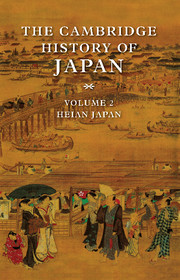Book contents
- Frontmatter
- Introduction
- 1 The Heian court, 794–1070
- 2 The capital and its society
- 3 Land and society
- 4 Provincial administration and land tenure in early Heian
- 5 Chinese learning and intellectual life
- 6 Aristocratic culture
- 7 Aristocratic Buddhism
- 8 Religious practices
- 9 Insei
- 10 The rise of the warriors
- Works cited
- Glossary-index
- Japan in the Heian period"
- References
7 - Aristocratic Buddhism
Published online by Cambridge University Press: 28 March 2008
- Frontmatter
- Introduction
- 1 The Heian court, 794–1070
- 2 The capital and its society
- 3 Land and society
- 4 Provincial administration and land tenure in early Heian
- 5 Chinese learning and intellectual life
- 6 Aristocratic culture
- 7 Aristocratic Buddhism
- 8 Religious practices
- 9 Insei
- 10 The rise of the warriors
- Works cited
- Glossary-index
- Japan in the Heian period"
- References
Summary
THE PRELUDE TO HEIAN BUDDHISM
Since its introduction into Japan in the middle of the sixth century, the Buddhist religion experienced steady growth under the patronage of the imperial family and powerful clans who sponsored the founding of magnificent temples and monasteries, which they generously endowed with gifts of agricultural land to provide an economic base for the upkeep of these institutions. The rapid expansion of the church is evident in the following figures taken from eighth-century sources. A census conducted in the year 624 – less than a century after Buddhism made its appearance at the court – revealed that there were forty-six functioning monasteries in Japan that accommodated a total of 816 monks and 569 nuns. By the year 681 the number of monasteries in the capital region alone had grown to twenty-four. Larger monasteries capable of accommodating hundreds of monks appeared during the course of the seventh century. Thus an entry in the Nihon shoki for the year 690 notes that gifts of cloth were presented to some 3,363 monks residing in seven monasteries.
Although we lack reliable figures for the total number of monasteries in Japan at this time, it is possible to confirm on the basis of archaeological evidence, mainly tiles and foundation stones, the existence of at least two hundred temple sites dating from the Asuka-Hakuhō period (593–710). As might be expected, most of these sites are in Yamato Province, although a few are found as far west as Bitchū and as far east as Owari, which gives some indication of the diffusion of Buddhism in this early period.
Keywords
- Type
- Chapter
- Information
- The Cambridge History of Japan , pp. 449 - 516Publisher: Cambridge University PressPrint publication year: 1999
References
- 4
- Cited by



